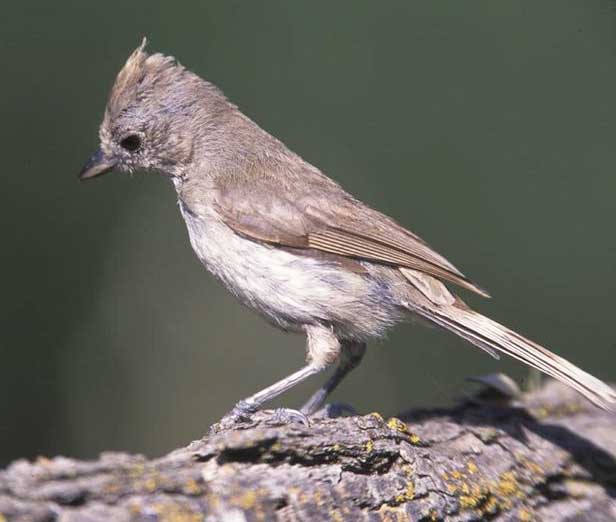
Baeolophus inornatus (*)
Superregnum: Eukaryota
Cladus: Unikonta
Cladus: Opisthokonta
Cladus: Holozoa
Regnum: Animalia
Subregnum: Eumetazoa
Cladus: Bilateria
Cladus: Nephrozoa
Superphylum: Deuterostomia
Phylum: Chordata
Subphylum: Vertebrata
Infraphylum: Gnathostomata
Megaclassis: Osteichthyes
Cladus: Sarcopterygii
Cladus: Rhipidistia
Cladus: Tetrapodomorpha
Cladus: Eotetrapodiformes
Cladus: Elpistostegalia
Superclassis: Tetrapoda
Cladus: Reptiliomorpha
Cladus: Amniota
Classis: Reptilia
Cladus: Eureptilia
Cladus: Romeriida
Subclassis: Diapsida
Cladus: Sauria
Infraclassis: Archosauromorpha
Cladus: Crurotarsi
Divisio: Archosauria
Cladus: Avemetatarsalia
Cladus: Ornithodira
Subtaxon: Dinosauromorpha
Cladus: Dinosauriformes
Cladus: Dracohors
Cladus: Dinosauria
Ordo: Saurischia
Cladus: Eusaurischia
Subordo: Theropoda
Cladus: Neotheropoda
Cladus: Averostra
Cladus: Tetanurae
Cladus: Avetheropoda
Cladus: Coelurosauria
Cladus: Tyrannoraptora
Cladus: Maniraptoromorpha
Cladus: Maniraptoriformes
Cladus: Maniraptora
Cladus: Pennaraptora
Cladus: Paraves
Cladus: Eumaniraptora
Cladus: Avialae
Infraclassis: Aves
Cladus: Euavialae
Cladus: Avebrevicauda
Cladus: Pygostylia
Cladus: Ornithothoraces
Cladus: Ornithuromorpha
Cladus: Carinatae
Parvclassis: Neornithes
Cohors: Neognathae
Cladus: Neoaves
Cladus: Telluraves
Cladus: Australaves
Ordo: Passeriformes
Subordo: Passeri
Infraordo: Passerida
Familia: Paridae
Genus: Baeolophus
Species: Baeolophus inornatus
Subspecies: B. i. affabilis – B. i. cineraceus – B. i. inornatus – B. i. mohavensis
Name
Baeolophus inornatus (Gambel, 1845)
Synonyms
Parus inornatus (protonym)
References
Proceedings of the Academy of Natural Sciences of Philadelphia 2: 265.
Vernacular names
čeština: Sýkora šedohnědá
dansk: Grå Topmejse
Deutsch: Schlichtmeise
English: Oak Titmouse
Esperanto: Senornama paruo
español: Cabonero sencillo
eesti: Tuhktihane
suomi: Kalifornianharmaatiainen
français: Mésange unicolore
italiano: Cincetta delle querce
日本語: ハイエボシガラ
Nederlands: Grijze Mees
norsk: Gråmeis
polski: Sikora kalifornijska
русский: Дубовая хохлатая синица
slovenčina: Sýkorka dubová
svenska: Kalifornisk gråmes
Tiếng Việt: Bạc má sồi
中文: 纯色冠山雀
The oak titmouse (Baeolophus inornatus) is a passerine bird in the tit family Paridae. The American Ornithologists' Union split the plain titmouse into the oak titmouse and the juniper titmouse in 1996, due to distinct differences in song, preferred habitat, and genetic makeup.[2]
The oak titmouse is a small, brown-tinged gray bird with small tuft or crest. The face is plain, and the undersides are a lighter gray. Sexes are similar, as there is very little to no sexual dimorphism.
This species lives year-round on the Pacific slope, resident from southern Oregon south through California west of the Sierra Nevada to Baja California, but its range surrounds the central San Joaquin Valley. It prefers open woodlands of warm, dry oak and oak-pine at low to mid-elevations but can also be found in forests as long as adequate oak trees are present.
The oak titmouse will sleep in cavities, dense foliage or birdhouses. When roosting in foliage, the titmouse chooses a twig surrounded by dense foliage or an accumulation of dead pine needles, simulating a roost in a cavity. It forms pairs or small groups, but does not form large flocks. It may join mixed-species flocks after breeding season for foraging. Pairs stay together after the breeding season.
Oak titmice eat insects and spiders, and are sometimes seen catching insects in mid air. They will also take berries, acorns, and some seeds. This species forages on foliage, twigs, branches, trunks, and occasionally on ground, sometimes hanging upside down to forage, and hammering seeds against branches to open them. Oak titmice are attracted to feeders with suet, peanut butter and sunflower seeds.
The song of the oak titmouse is a series of repeated phrases of two or three notes with the last note of lower pitch; usually three to seven phrases are grouped together. The call is a scratchy tsicka-dee-dee.
The oak titmouse builds its nest in a woodpecker hole, a natural cavity, or a nest box, using grass, moss, mud, hair, feathers, and fur. It breeds from March into July, with peak activity in April and May, laying 3–9 eggs, usually 6–8. The female is the primary incubator, with incubation taking 14–16 days. Young are altricial and are tended by both parents in nest for 16–21 days. Parents continue to tend to young for another three to four weeks after they leave the nest.
The oak titmouse and juniper titmouse appear almost identical, but differ in voice as well as range. The oak titmouse has a browner back than the juniper titmouse. The oak titmouse gives a repeated series of three to seven syllables, each comprising one low and one high note, while the juniper titmouse song consists of a series of rapid syllables on the same note. Ranges overlap only in a small area in California. The tufted titmouse, which does not overlap in range, has a whiter belly, rusty flanks, and black on the forehead.
References
BirdLife International (2017). "Baeolophus inornatus". IUCN Red List of Threatened Species. 2017: e.T22711978A111066495. doi:10.2305/IUCN.UK.2017-1.RLTS.T22711978A111066495.en. Retrieved 12 November 2021.
Banks, Richard C.; Fitzpatrick, John W.; Howell, Thomas R.; Johnson, Ned K.; Monroe, Burt L.; Ouellet, Henri; Remsen, J. V.; Storer, Robert W. (July 1997). "Forty-first supplement to the American Ornithologists' Union Check-list of North American Birds" (PDF). The Auk. 114 (3): 542–552. doi:10.2307/4089270. JSTOR 4089270.
Further reading
Alsop, Fred J., III (2001). Smithsonian Birds of North America, Western Region. New York City: DK Publishing, Inc. ISBN 0-7894-7157-4.
Sibley, David Allen (2000). The Sibley Guide to Birds. New York: Knopf. p. 483. ISBN 0-679-45122-6.
Retrieved from "http://en.wikipedia.org/"
All text is available under the terms of the GNU Free Documentation License

